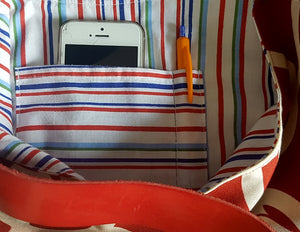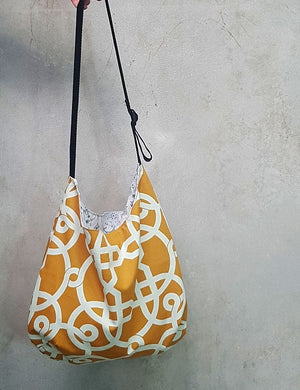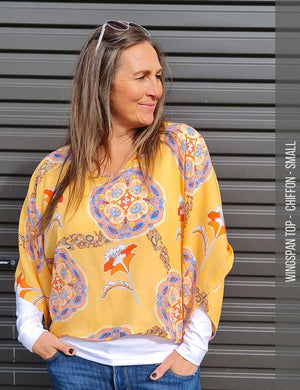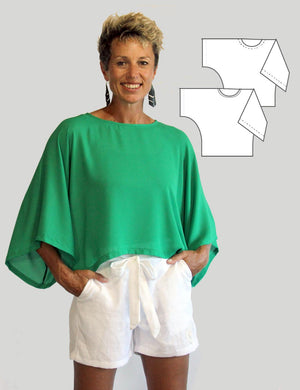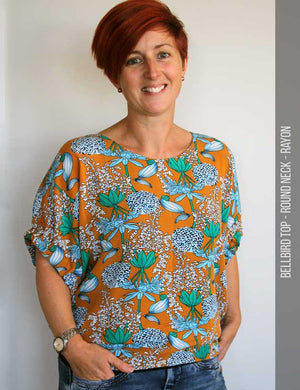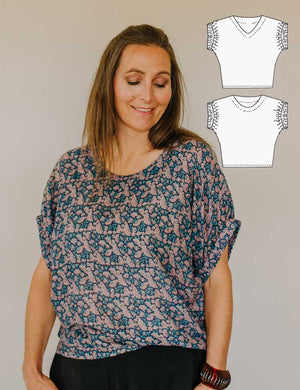1. DOWNLOAD the FREE PJ pattern right here.
2. BEFORE YOU PRINT your PDF pattern please check the Printing instructions.
It is very important that you print your pattern to scale (unless you want to make PJ pants for a doll or a giant!). Ensure your Printer is set to print at 100% Actual Size and with the Print With Borders setting turned on. Please refer our "Printing and Compiling Instructions" here.
You may also like to read more about our patterns before you get started.

We found our pillowcase at SaveMart for 99c. You probably have some pillowcases you havn't used for a while in your linen cupboard...........

3. Once you have printed and cut out your paper pattern, layout your pillowcase and place the paper pattern piece on top. Make sure the vertical arrow on the pattern aligns with the warp or weft threads of the pillowcase. The warp and weft threads are the threads that go down and across the fabric to weave it together, which you can see if you look very closely. Usually a pattern will require you to align the vertical arrow in the main direction of the fabric (the warp thread going length-wise), but in a regular weave (like a cotton pillowcase), the warp and weft threads are relatively even in strength so you can lay the pattern across or down. The PJ pattern should fit across the pillowcase (in line with the weft thread).
4. Keep the pattern still by placing a paper weight (or another heavy object) on top. Draw around the pattern with fabric chalk (or use a pen mark). Be sure to mark the notches which will help you line up the fabric as you are sewing.
5. Cut out the pattern shape around the outside.

6. With the right sides together, pin the 2 pieces of fabric together along the seam line to ensure the pieces do not move around when you start sewing.
7. Sew along the FRONT seam line (from the waistline to the bottom of the crutch. Repeat for the BACK seam line.

8. Clip the 2 crutch seams as shown. When sewing corners you need to cut small triangles so the fabric does not bunch up on the inside of the garment. Clipping helps remove the bulk of fabric in a curved seam
OR
You may prefer to zig-zag in the space between the raw edge of the fabric and the crutch seam with the outside edge of the zig-zag just touching (or slightly over) the raw edge . This stops the raw edge from fraying, draws the seam inwards a little and also strengthens the seam.
9. Open up the pants, keeping the wrong side up (right side of fabric together), so that the front and back seams sit on top of one another. Press open the seam.

10. Pin the front and back crutch seams together. Sew.
11. To hem the legs. Fold 1cm up from the bottom edge of each leg. Press flat with an iron. Then fold again up 1.5 cm. Press and pin in place. The folded edge of the fabric should be in line with the dotted hem line marked on the pattern. Measure and check. Correct if necessary. Sew in place.
12.To hem the waist and create a channel for the elastic; fold down 1 cm from the top edge and press flat with an iron. Fold down 3 cm and press again.

Make sure you leave a 2 cm gap at the back to insert the elastic. Mark the gap and sew the waistband channel.

13. Measure the elastic around your waist so it is firm but not tight. Cut the length to your waist measurement plus a 1 inch overlap. Thread the elastic through the waistband by clipping a safety pin to one end of the elastic and feeding it through until it comes out of the gap again.

14. Make sure the elastic is not twisted inside the waistband. Overlap both ends by 1 inch and sew together using a zig zag stitch. Massage the elastic so it sits back inside the waist band.

15. You may choose to embellish your PJ pants with a front ribbon. We have simply sewn the center of the ribbon to the waistband and then tied a bow.

16. Now you can upload a photo and share with your friends in the SEWING REVIVAL community on Facebook and Instagram. We'd really love your feedback.


